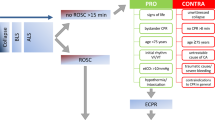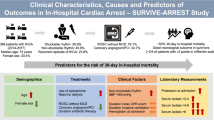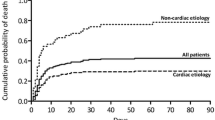Abstract
Objective
Data are lacking on the relationship between postresuscitation ECG and outcome in out-of-hospital cardiac arrest (OHCA). We examined the prognostic information that postresuscitation ECG rhythm can provide for predicting outcome in OHCA survivors.
Methods
The retrospective observational study enrolled 56 successfully resuscitated nontraumatic adult OHCA patients. Postresuscitation 12-lead ECGs of the enrolled patients were interpreted independently by two cardiologists. We compared baseline clinical characteristics, CPR process, and outcome in the 8 patients with postresuscitation accelerated idioventricular rhythm (AIVR, n = 8) and the 48 without AIVR.
Results
The AIVR group had a higher proportion of patients with coronary artery disease (50% vs. 15%), initial ventricular tachycardia/fibrillation rhythm (50% vs. 8%), and cardiac origin of OHCA (75% vs. 23%). AIVR patients had longer total CPR duration (32 vs. 18 min) and higher dose of epinephrine use (10 vs. 3 mg). Postresuscitation AIVR was associated with an increased incidence of repeated CPR within 1 h after return of spontaneous circulation (38% vs. 4%), and lower 7-day survival rate (0% vs. 50%).
Conclusions
AIVR on postresuscitation ECG offers a prognostic factor related to a higher repeated CPR rate within 1 h after return of spontaneous circulation and a lower 7-day survival rates in successfully resuscitated OHCA victims.


Similar content being viewed by others
References
Tsai MS, Chiang WC, Lee CC, Hsieh CC, Ko PC, Hsu CY, Su CP, Chen SY, Chang WT, Yuan A, Ma MH, Chen SC, Chen WJ (2005) Infections in the survivors of out-of-hospital cardiac arrest in the first 7 days. Intensive Care Med 31:621–626
Morrison LJ, Visentin LM, Kiss A, Theriault R, Eby D, Vermeulen M, Sherbino J, Verbeek PR; TOR Investigators (2006) Validation of a rule for termination of resuscitation in out-of-hospital cardiac arrest. N Engl J Med 355:478–487
Bunch TJ, White RD, Bruce GK, Hammill SC, Gersh BJ, Shen WK, Carter MA, Packer DL (2004) Prediction of short- and long-term outcomes by electrocardiography in survivors of out-of-hospital cardiac arrest. Resuscitation 63:137–143
Laurent I, Monchi M, Chiche JD, Joly LM, Spaulding C, Bourgeois B, Cariou A, Rozenberg A, Carli P, Weber S, Dhainaut JF (2002) Reversible myocardial dysfunction in survivors of out-of-hospital cardiac arrest. J Am Coll Cardiol 40:2110–2116
Booth CM, Boone RH, Tomlinson G, Detsky AS (2004) Is this patient dead, vegetative, or severely neurologically impaired? Assessing outcome for comatose survivors of cardiac arrest. JAMA 291:870–879
Huang CH, Chen WJ, Ma MH, Chang WT, Lai CL, Lee YT (2002) Factors influencing the outcomes after in-hospital resuscitation in Taiwan. Resuscitation 53:265–270
Weng TI, Huang CH, Ma MH, Chang WT, Liu SC, Wang TD, Chen WJ (2004) Improving the rate of spontaneous circulation for out-of-hospital cardiac arrests with a formal, structured emergency resuscitation team. Resuscitation 60:137–142
Ko PC, Ma MH, Yen ZS, Shih CL, Chen WJ, Lin FY (2004) Impact of community-wide deployment of biphasic waveform automated external defibrillators on out-of-hospital cardiac arrest in Taipei. Resuscitation 63:167–174
Ko PC, Chen WJ, Lin CH, Ma MH, Lin FY (2005) Evaluating the quality of prehospital cardiopulmonary resuscitation by reviewing automated external defibrillator records and survival for out-of-hospital witnessed arrests. Resuscitation 64:163–169
Chang WT, Ma MH, Chien KL, Huang CH, Tsai MS, Shih FY, Yuan A, Tsai KC, Lin FY, Lee YT, Chen WJ (2007) Postresuscitation myocardial dysfunction: correlated factors and prognostic implications. Intensive Care Med 33:88–95
Massumi RA, Ali N (1970) Accelerated isorhythmic ventricular rhythms. Am J Cardiol 26:170–185
Grimm W, Marchlinski FE (2004) Accelerated idioventricular rhythm, bidirectional tachycardia. In: Zipes DP, Jalife J (eds) Cardiac electrophysiology. From cell to bedside, 4th edn. Saunders, Philadelphia, pp 700–706
Grimm W, Hoffmann J, Menz V, Schmidt C, Muller HH, Maisch B (2000) Significance of accelerated idioventricular rhythm in idiopathic dilated cardiomyopathy. Am J Cardiol 85:899–904
Chiladakis JA, Pashalis A, Patsouras N, Manolis AS (2001) Autonomic patterns preceding and following accelerated idioventricular rhythm in acute myocardial infarction. Cardiology 96:24–31
Shah PK, Cercek B, Lew AS, Ganz W (1993) Angiographic validation of bedside markers of reperfusion. J Am Coll Cardiol 21:55–61
Spaulding CM, Joly LM, Rosenberg A, Monchi M, Weber SN, Dhainaut JF, Carli P (1997) Immediate coronary angiography in survivors of out-of-hospital cardiac arrest. N Engl J Med 336:1629–1633
Wang FS, Lien WP, Fong TE, Lin JL, Cherng JJ, Chen JH, Chen JJ (1986) Terminal cardiac electrical activity in adults who die without apparent cardiac disease. Am J Cardiol 58:491–495
Tang W, Weil MH, Sun S, Noc M, Yang L, Gazmuri RJ (1995) Epinephrine increases the severity of postresuscitation myocardial dysfunction. Circulation 92:3089–3093
Engdahl J, Bang A, Karlson BW, Lindqvist J, Herlitz J (2003) Characteristics and outcome among patients suffering from out of hospital cardiac arrest of non-cardiac aetiology. Resuscitation 57:33–41
Gallagher JJ, Damato AN, Lau SH (1971) Electrophysiologic studies during accelerated idioventricular rhythms. Circulation 44:671–677
Author information
Authors and Affiliations
Corresponding author
Rights and permissions
About this article
Cite this article
Tsai, MS., Huang, CH., Chen, HR. et al. Postresuscitation accelerated idioventricular rhythm: a potential prognostic factor for out-of-hospital cardiac arrest survivors. Intensive Care Med 33, 1628–1632 (2007). https://doi.org/10.1007/s00134-007-0633-z
Received:
Accepted:
Published:
Issue Date:
DOI: https://doi.org/10.1007/s00134-007-0633-z




